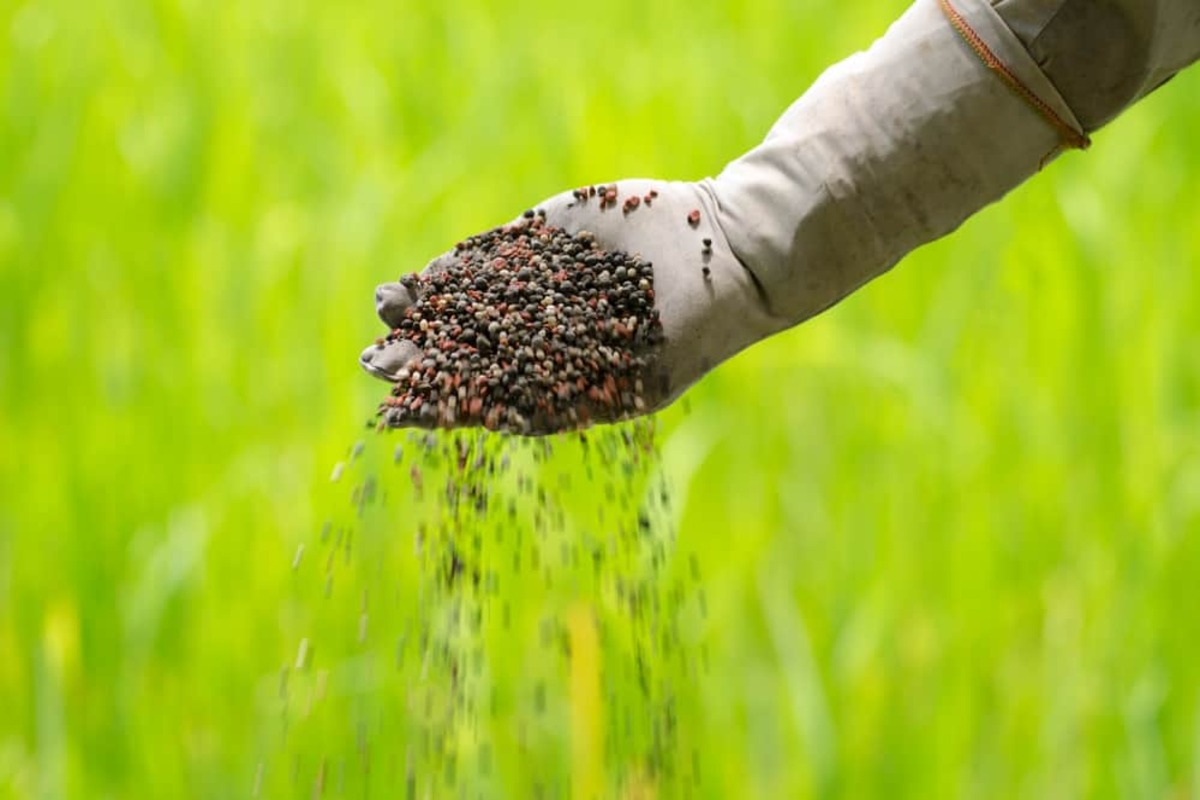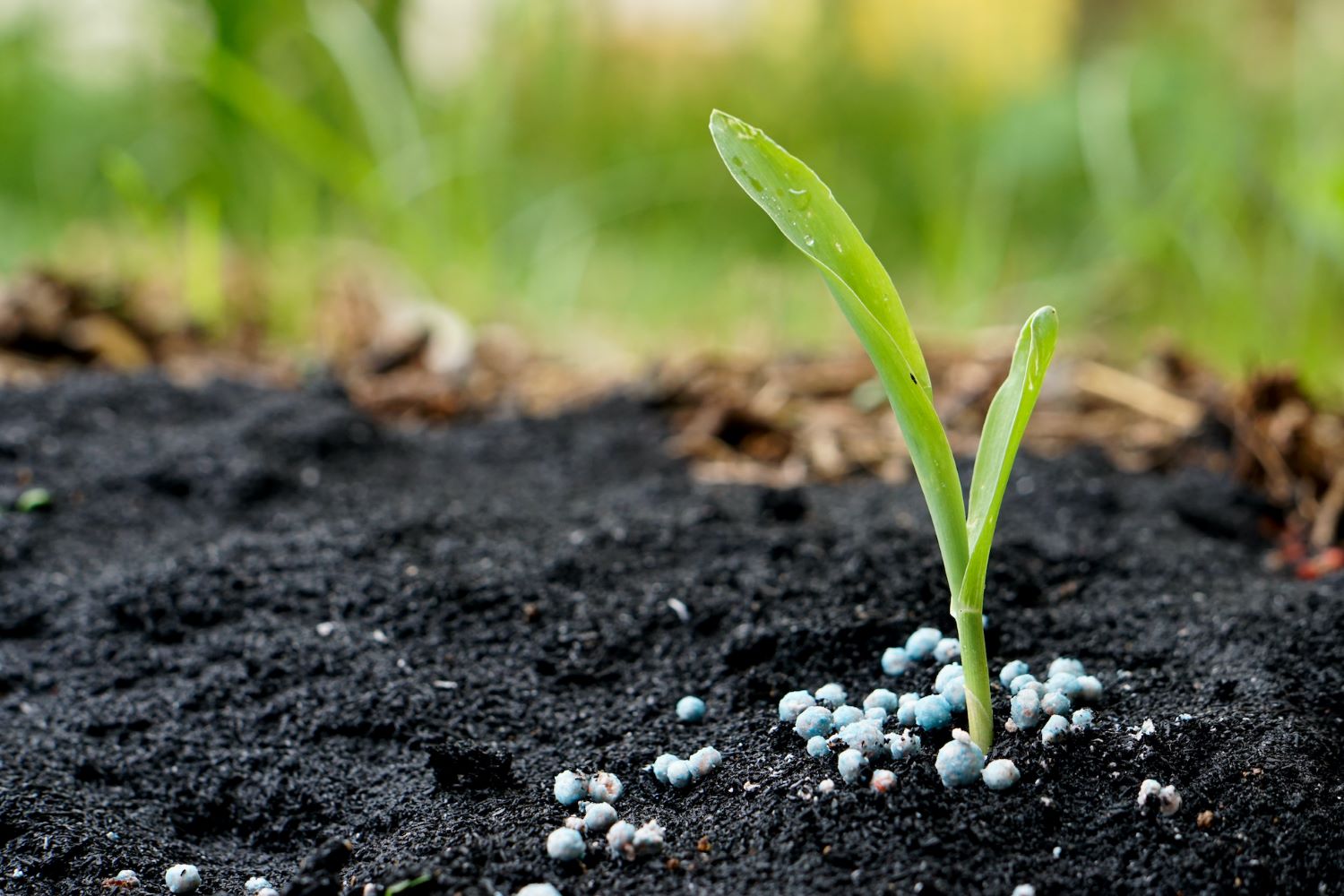Home>Gardening Basics>How Long Does Lawn Fertilizer Last


Gardening Basics
How Long Does Lawn Fertilizer Last
Modified: January 22, 2024
Learn everything you need to know about getting started with lawn fertilizer and discover how long it lasts for optimal results.
(Many of the links in this article redirect to a specific reviewed product. Your purchase of these products through affiliate links helps to generate commission for Chicagolandgardening.com, at no extra cost. Learn more)
Table of Contents
Introduction
Welcome to the world of lawn care, where a lush and vibrant lawn is the pride of every homeowner. Achieving a healthy lawn requires proper maintenance, and one essential aspect is using lawn fertilizer. But have you ever wondered how long lawn fertilizer lasts?
Lawn fertilizer is a vital component in promoting healthy grass growth and maintaining the overall health of your lawn. It provides essential nutrients that grass needs to thrive, such as nitrogen, phosphorus, and potassium. However, the longevity of fertilizer can vary depending on several factors.
In this article, we will dive deep into the world of lawn fertilizer and explore how long it typically lasts. Whether you use synthetic or organic fertilizer, understanding its lifespan will help you make informed decisions about how often and when to apply it.
So, if you want to ensure your lawn stays lush and green throughout the year, read on to discover everything you need to know about the longevity of lawn fertilizer.
Understanding Lawn Fertilizer
Lawn fertilizer is a specially formulated product designed to provide essential nutrients to grass in order to promote healthy root development, vigorous growth, and overall lawn health. It typically contains a combination of nitrogen (N), phosphorus (P), and potassium (K), as well as other trace minerals and micronutrients.
The key role of lawn fertilizer is to replenish and supplement the nutrients that may be lacking in the soil. As grass grows, it naturally depletes the soil of these nutrients, and that’s where fertilizer comes in. By supplying the necessary nutrients, fertilizer helps to ensure that your lawn remains healthy, green, and resistant to disease and pest infestations.
It’s important to note that not all fertilizers are created equal. There are two main types of lawn fertilizers: synthetic and organic. Synthetic fertilizers are typically made from chemically derived compounds, while organic fertilizers are made from natural sources like animal manure, compost, or plant materials. Each type of fertilizer has its own unique properties and benefits.
Regardless of the type you choose, proper application is crucial. Overapplying or applying fertilizer at the wrong time can lead to nutrient runoff, environmental pollution, and damage to plant and animal life. It’s essential to follow the manufacturer’s instructions and local regulations when it comes to applying lawn fertilizer.
Now that we’ve covered the basic understanding of lawn fertilizer, let’s delve into the factors that can affect the longevity of fertilizer and how long you can expect it to last.
Factors Affecting the Longevity of Fertilizer
The longevity of lawn fertilizer can be influenced by several factors, which can vary depending on the type of fertilizer you’re using. Understanding these factors can help you determine how long your fertilizer will last and when it may need to be reapplied.
1. Soil Conditions: The composition and health of your soil play a significant role in how long lawn fertilizer lasts. Sandy soils, for example, tend to drain more quickly, which may result in the nutrients being flushed out faster. Clay soils, on the other hand, can hold onto nutrients for longer periods. Testing your soil will provide valuable insights into its nutrient levels and composition, allowing you to make informed decisions about fertilizer application.
2. Climate and Weather: The weather conditions in your area can affect the longevity of lawn fertilizer. Heavy rainfall or irrigation can leach nutrients out of the soil, requiring more frequent applications. In contrast, dry and arid climates may require less frequent application as there is less water to carry away the nutrients.
3. Fertilizer Type: The type of fertilizer you use also plays a role in its longevity. Synthetic fertilizers are usually designed to release nutrients quickly and provide immediate results. However, the nutrients in synthetic fertilizers may also dissipate more rapidly. Organic fertilizers, on the other hand, release nutrients slowly over time and have a longer-lasting effect.
4. Application Rate: Applying the correct amount of fertilizer is crucial. Overapplication can lead to nutrient runoff and waste, while underapplication may result in inadequate nutrient supply for your lawn. Following the manufacturer’s recommended application rates will ensure optimal nutrient uptake and longevity.
5. Grass Type and Growth Stage: Different grass species have varying nutrient requirements and growth rates. Cool-season grasses, such as Kentucky bluegrass or fescue, have higher nutrient requirements and may require more frequent fertilization. Warm-season grasses, like Bermuda grass or Zoysia grass, have slower growth rates and may not need fertilizer as often.
By considering these factors and monitoring the condition of your lawn, you can adjust the timing and frequency of fertilizer applications to maximize its effectiveness and ensure the longevity of your lawn fertilizer.
Different Types of Lawn Fertilizers
When it comes to lawn fertilizers, there are primarily two main types: synthetic and organic. Each type has its own advantages and considerations, so let’s take a closer look at both:
1. Synthetic Fertilizers: Synthetic fertilizers are manufactured using chemically derived compounds. They are widely available and offer quick-release nutrients that are readily available for plants to absorb. These fertilizers typically contain a higher concentration of nitrogen, phosphorus, and potassium compared to organic fertilizers. The quick-release nature of synthetic fertilizers means that they provide rapid greening and growth, making them a popular choice for those seeking immediate results. However, the nutrients in synthetic fertilizers can dissipate more quickly, requiring more frequent applications. It’s essential to follow the recommended application rates and not to overapply, as this can cause nutrient runoff and harm the environment.
2. Organic Fertilizers: Organic fertilizers are derived from natural sources such as animal manure, compost, bone meal, or plant materials. They release nutrients slowly over time through natural decomposition and microbial activity. Organic fertilizers enrich the soil by improving its structure and promoting beneficial microorganisms. The slow-release nature of organic fertilizers means that they provide a steady and consistent supply of nutrients to the lawn, resulting in long-term growth and overall soil health. While organic fertilizers may offer a milder and more sustainable approach, they tend to have lower nutrient concentrations compared to synthetic fertilizers. As a result, they may require more frequent applications to meet the nutrient needs of the lawn. Organic fertilizers are an excellent choice for those looking for environmentally friendly and sustainable lawn care solutions.
It’s worth noting that there are also specialized fertilizers available for specific purposes, such as weed and feed fertilizers that contain herbicides to control weeds, or slow-release fertilizers that offer a more controlled nutrient release over an extended period of time. Consider your specific lawn care needs and goals when selecting the right type of fertilizer for your lawn.
Ultimately, choosing between synthetic and organic fertilizers boils down to personal preference, environmental considerations, and desired long-term outcomes. Regardless of your choice, proper application techniques and adherence to recommended rates will ensure the effective use of lawn fertilizers for a healthy and vibrant lawn.
How Long Does Synthetic Fertilizer Last?
Synthetic fertilizers are known for their quick-release nature, providing immediate results by delivering nutrients that are readily available for plant uptake. However, the lifespan of synthetic fertilizers can vary based on several factors:
1. Nutrient Release Rate: Synthetic fertilizers are designed to release nutrients rapidly, which means they can provide a quick boost to your lawn. The nutrients are dissolved in water and absorbed by the grass roots. Depending on the formulation of the fertilizer, this release can happen within a few days to a few weeks after application.
2. Environmental Conditions: Environmental factors such as temperature, moisture, and sunlight can affect the longevity of synthetic fertilizers. Higher temperatures and increased moisture levels can accelerate nutrient release from the fertilizer, resulting in a shorter lifespan. In contrast, cooler temperatures and drier conditions can slow down the release, extending the fertilizer’s effectiveness.
3. Application Rate and Timing: The amount of synthetic fertilizer applied and the timing of application play a role in how long it lasts. Applying excessive amounts of fertilizer can cause nutrient runoff, wasting the product and potentially damaging the environment. Following the recommended application rates is crucial for optimal performance. Additionally, applying fertilizer during periods of active grass growth will maximize nutrient uptake and utilization.
4. Grass Type and Growth Rate: Different grass species have varying nutrient requirements and growth rates. Cool-season grasses, such as Kentucky bluegrass or fescue, have higher nutrient needs and may require more frequent fertilization. Warm-season grasses, like Bermuda grass or Zoysia grass, have slower growth rates and may not need fertilizer as often. Considering the specific needs of your grass type will help you determine the frequency of synthetic fertilizer application.
In general, synthetic fertilizers typically last for several weeks to a few months. To maintain a healthy and vibrant lawn, it is often recommended to reapply synthetic fertilizer every 6-8 weeks during the active growing season. However, it’s important to monitor the appearance of your lawn and conduct soil tests to assess nutrient levels and determine if additional fertilizer applications are necessary.
Remember, proper storage of synthetic fertilizers is also crucial for maintaining their effectiveness. Ensure that they are stored in a cool, dry place, away from direct sunlight and moisture, to prevent nutrient degradation and maintain their potency.
By understanding the lifespan of synthetic fertilizers and considering the factors mentioned above, you can make informed decisions about when to reapply fertilizer and keep your lawn looking lush and healthy throughout the year.
How Long Does Organic Fertilizer Last?
Organic fertilizers are derived from natural sources such as animal manure, compost, or plant materials. Unlike synthetic fertilizers, organic fertilizers release nutrients slowly over time through natural decomposition and microbial activity. The lifespan of organic fertilizer can vary due to several factors:
1. Nutrient Release Rate: Organic fertilizers break down gradually, releasing nutrients over an extended period. The rate of nutrient release depends on factors such as moisture, temperature, and microbial activity in the soil. Typically, organic fertilizers last longer than synthetic fertilizers, providing a slow and consistent supply of nutrients to the lawn.
2. Soil Conditions: The composition and health of the soil affect how long organic fertilizer lasts. Microbes in the soil break down organic matter and release nutrients. If the soil has high microbial activity and favorable conditions, the decomposition process will be faster, leading to quicker nutrient release. Conversely, if the soil lacks microbial activity or is too acidic or alkaline, the breakdown process may be slower, prolonging the lifespan of organic fertilizer.
3. Organic Matter Quality: The quality of organic matter used in the fertilizer influences its longevity. Well-aged compost or fully decomposed organic materials release nutrients more efficiently compared to fresher or less mature organic matter. Higher-quality organic fertilizers can provide longer-lasting effects since the nutrients are more readily available for plant uptake.
4. Application Rate and Timing: Similar to synthetic fertilizers, the application rate and timing of organic fertilizers can impact their lifespan. Applying too much organic fertilizer can overwhelm the soil’s capacity to break it down efficiently, resulting in nutrient runoff or nutrient imbalances. Following recommended application rates and spacing out applications based on the specific fertilizer’s instructions will ensure optimal nutrient release and longevity.
5. Grass Type and Nutrient Requirements: Different grass species have varying nutrient needs. Cool-season grasses may require more frequent applications of organic fertilizer compared to warm-season grasses. Understanding the nutrient requirements of your specific grass type will help you determine the frequency of organic fertilizer application to maintain a healthy and vibrant lawn.
Typically, organic fertilizers last anywhere from a few weeks to several months, depending on the factors mentioned above. To ensure continuous nutrient supply, it’s recommended to reapply organic fertilizer every 4-6 weeks during the growing season. Regularly monitoring the health and appearance of your lawn and conducting soil tests can help you gauge its nutrient needs and determine if additional applications are necessary.
Keep in mind that while organic fertilizers may have a slower release rate compared to synthetics, their long-term benefits include improving soil health, enhancing microbial activity, and promoting overall sustainability in lawn care practices.
By understanding how long organic fertilizers last and considering these factors, you can effectively manage their application and ensure a nourished and thriving lawn.
Tips for Extending the Lifespan of Fertilizer
Maximizing the longevity of your lawn fertilizer can help you get the most out of each application and maintain a healthy and vibrant lawn. Here are some tips to extend the lifespan of your fertilizer:
- Proper Application Techniques: Follow the manufacturer’s instructions regarding the application rate and method. Overapplication can lead to nutrient runoff, wasting the fertilizer and potentially harming the environment. Applying the correct amount ensures optimal nutrient uptake and utilization by the grass.
- Timing: Apply the fertilizer at the appropriate time, considering the specific needs of your grass type. Apply fertilizer during periods of active growth to enhance nutrient absorption and utilization. Avoid applying fertilizer during extreme weather conditions, such as heatwaves, or when heavy rainfall is expected, as this can result in nutrient runoff and reduced effectiveness.
- Soil Testing: Regularly test your soil to assess its nutrient levels and pH. This will help you determine the precise nutrient requirements of your lawn and guide your fertilizer application. Soil tests can also reveal any imbalances or deficiencies that need to be addressed, allowing you to customize your fertilizer program accordingly.
- Watering Practices: Proper watering is essential for promoting nutrient uptake and extending the lifespan of fertilizer. Water the lawn deeply but infrequently to encourage deep root growth. This will help the grass access nutrients from the soil more efficiently and reduce the risk of nutrient leaching. Avoid excessive watering, as it can cause nutrients to leach out of the soil, wasting the fertilizer.
- Grass Clippings: Leave grass clippings on the lawn after mowing. They act as a natural mulch and can contribute to the organic matter content of the soil, gradually releasing nutrients back into the grass. This helps in extending the lifespan of your fertilizer and promotes a healthier, more resilient lawn.
- Proper Storage: Store your fertilizer in a cool, dry place away from direct sunlight and moisture. Exposure to these elements can lead to nutrient breakdown and reduced efficacy. Proper storage will keep your fertilizer potent and extend its lifespan, allowing you to use it over multiple applications.
By implementing these tips, you can effectively extend the lifespan of your lawn fertilizer, reduce waste, and ensure your lawn receives optimal nourishment for long-lasting health and beauty.
Signs that Fertilizer is No Longer Effective
Identifying signs that your fertilizer is no longer effective is essential for maintaining a healthy and vibrant lawn. Here are some indicators that your fertilizer may no longer be providing the desired results:
- Lack of Growth: If you notice minimal or stunted growth despite regular fertilization, it may indicate that the nutrients in the fertilizer are no longer sufficient for your lawn’s needs. This can happen if the fertilizer has been depleted or if the soil conditions have changed.
- Pale or Yellowing Grass: Fertilizer is responsible for providing essential nutrients that contribute to the green and vibrant color of your lawn. If your grass starts to appear pale or yellow, it may be a sign of nutrient deficiency. This could indicate that the fertilizer has been exhausted or is no longer being effectively absorbed by the grass.
- Increased Weed Growth: Fertilizer helps promote healthy grass growth, which in turn helps suppress weed growth. If you start to notice an influx of weeds in your lawn despite regular fertilization, it could be an indication that your current fertilizer is no longer effectively supporting your grass and its ability to compete with weeds.
- Soil Nutrient Test Results: Regularly conducting soil tests can provide valuable insights into the nutrient levels in your soil. If your recent soil test results indicate low nutrient levels, it may suggest that the fertilizer you have been using is no longer adequately replenishing the nutrients in the soil.
- Poor Water Retention: Fertilizers help improve the soil’s ability to retain moisture, aiding in the overall health and vibrancy of the grass. If you notice that your lawn is struggling to retain moisture, resulting in increased water requirements, it could be a sign that your fertilizer is no longer effective in improving water retention.
- Increased Disease and Pest Susceptibility: A healthy, well-nourished lawn is less susceptible to disease and pest infestations. If you notice an increase in disease outbreaks or pest activity in your lawn despite regular fertilization, it may indicate that the fertilizer is no longer providing the necessary nutrients to strengthen the grass’s defenses.
If you observe any of these signs, it may be time to reevaluate your fertilizer program and consider making adjustments. Conducting a soil test, consulting with a lawn care professional, or changing to a different type or brand of fertilizer may be necessary to address the specific needs of your lawn and restore its health and vitality.
Remember that regular monitoring and proper maintenance practices are key to a thriving lawn, and adjusting your fertilizer strategy based on the signs of ineffectiveness will help ensure optimal results.
Conclusion
Understanding how long lawn fertilizer lasts is crucial for effective lawn care and maintenance. Both synthetic and organic fertilizers provide essential nutrients to promote healthy grass growth and overall lawn health. Synthetic fertilizers offer quick release of nutrients for immediate results, while organic fertilizers provide a slow and steady release over time.
The longevity of fertilizer is influenced by various factors, including soil conditions, climate, fertilizer type, application rate, grass type, and growth stage. Sandy soils, heavy rainfall, and faster grass growth can lead to quicker nutrient depletion and require more frequent fertilizer applications. On the other hand, clay soils, dry climates, and slower grass growth may extend the lifespan of the fertilizer.
To maximize the effectiveness and lifespan of your fertilizer, it is essential to follow proper application techniques, consider the specific needs of your grass type, conduct regular soil tests, and store the fertilizer in appropriate conditions. Monitoring your lawn’s appearance, looking out for signs of nutrient deficiency, and adjusting your fertilizer strategy accordingly are also important for maintaining a healthy and vibrant lawn.
Whether you choose synthetic or organic fertilizers, responsible and informed use is key. Assessing your lawn’s needs, adhering to recommended application rates, and considering environmental factors will help you make the most of your fertilizer and minimize any negative impact on the environment.
Remember, achieving a lush and healthy lawn requires a holistic approach that includes proper watering, mowing, and regular maintenance in addition to the application of fertilizer. By combining these practices, you can create an environment that promotes strong, vibrant, and resilient grass growth.
So, the next time you reach for that bag of fertilizer, consider the factors that affect its lifespan, apply it correctly, and enjoy the rewards of a stunning lawn that enhances the beauty of your home.









